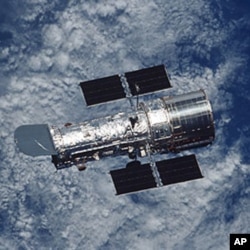Ever since the days of Galileo and the first optical telescopes more than 400 years ago, astronomers have been looking for ways to cast their gaze farther into the heavens around us. Today, thanks to the earth-orbiting Hubble Space Telescope, that gaze extends to the very edges of the known universe.
On April 24, 1990, the U.S. space shuttle Discovery roared into orbit carrying the special instrument which would revolutionize our knowledge of the universe.
The Hubble Space Telescope was designed to orbit the earth - far above the obscuring haze of the earth’s atmosphere - observing planets, stars, galaxies and other distant celestial objects with unprecedented clarity.
The school bus-sized telescope, named after American astronomer Edwin P. Hubble, took 10 years to build at a cost of $1.5 billion. More than 10,000 people were involved in its design and construction.
Nancy Grace Roman is considered the “mother” of the Hubble. As the first chief astronomer at the U.S. space agency, NASA, Roman played a pivotal role in Hubble’s early planning and development.
She travelled around the country, talking with astronomers about what they needed in a new telescope.
“Astronomers had been wanting to get observations from above the atmosphere for a long time," says Roman. "Looking through the atmosphere is somewhat like looking through a piece of old, stained glass. The glass has defects in it, so the image is blurred from that.”
Roman set up a committee of astronomers, and NASA engineers to design a large and serviceable observatory that would orbit above the atmosphere and transmit clear images of the universe back to earth.
Ed Weiler, NASA’s current chief astronomer, worked with Roman and has been intimately involved with the Hubble program since he succeeded her in 1979.
“The Hubble, when it was launched, represented an increase in capability of other telescopes on the ground by a factor of 10," he says. "The last time in human history in astronomy that we leaped a factor of 10, in one step, was when Galileo stopped using his eye and put the first telescope to his eye.”
Despite an initial glitch with a defective mirror, Hubble’s mission of observation and discovery has been historic. The telescope’s wide-field camera has captured and transmitted stunning images of celestial objects back to earth, many of them more distant than anything seen before.
“The Hubble can see things that are billions of times fainter than your human eye can see, and it can resolve objects very, very much more clearly," says Weiler. "For instance, you can see a firefly on the moon with the Hubble, whereas you wouldn’t see that with your eye.”
Roman recalls how excited she was to see her first Hubble pictures.
“I think the image that to me was most striking was a picture of the center of a globular cluster," she says. "You could see each star individually, and see their color, and it was just a fantastic sight.”
Since its deployment more than 20 years ago, Hubble has expanded our knowledge of the universe a thousand-fold. The telescope has been upgraded in a series of space shuttle servicing missions. Its images of distant stars and galaxies have allowed astronomers to calculate that the universe was born about 14 billion years ago, a much more accurate measure than the old estimate of somewhere between 10 to 20 billion years.
Weiler says another of Hubble’s many scientific milestones was its confirmation of the existence of dark energy, a force that’s speeding the expansion of the universe. Hubble also proved that mysterious gravitational vortexes, known as black holes, exist at the center of most galaxies.
“Black holes were science fiction. "Star Trek," "Star Wars," "Black Holes"; nice theory but nobody believes in them right?" says Weiler. "Hubble proved they exist.”
On July 4 of this year, the Hubble Space Telescope completed its one millionth science observation; a spectrograph of an exoplanet 1,000 light-years away.
Today, the earth-orbiting observatory continues to perform what is widely hailed as one of the most successful space science missions in history.
As plans proceed for the launch of a new and even more powerful earth-orbiting telescope, Hubble is expected to remain in service for at least another decade, continuing to revolutionize astronomy and expand our knowledge of the universe.


